To ensure your emails land where they’re supposed to, that is, recipient’s inboxes, you need to do some proper email deliverability testing.
And, in this article, I’ll provide you with the email deliverability tools you need to conduct these tests, show you how to use them, as well as break down:
- The results of email deliverability tests we’ve performed [jump ahead]
- How to test email deliverability and its different aspects [jump ahead]
- The criteria I’ve used to select the testing tools on this list [jump ahead]
- The features, pricings, and other nuances for each tool [jump ahead]
To freshen up your knowledge on email deliverability itself or learn a bit extra about it, be sure to check out our dedicated article on the topic.
Email deliverability testing tools: a snapshot
To make it easier for you to choose and for a more well-rounded selection, I’ll showcase 1 tool for analyzing email content in a sandbox, 2 email deliverability and spam testing tools, and 2 sender reputation and domain health tools. These include:
- Email Sandbox for devs and QAs to inspect and debug emails in a safe environment, as well as for marketers who want to see how their emails perform from different angles.
- GlockApps for users who want an in-depth deliverability solution that comes at a price.
- MailerCheck for those who want a more minimal and affordable GlockApps variant.
- SenderScore for those who are just getting into email marketing and or who want to test their personal projects’ deliverability.
- MXToolbox for either users who need a simple free solution or those who want advanced testing tools that come with the paid plan.
And for your convenience, here’s a chart with a brief overview of each testing tool:
| Feature | Email Sandbox | Glock Apps | Mailer Check | Sender Score | Mx Toolbox |
| Inbox placement testing | ❌ | ✅ | ✅ | ❌ | ❌ |
| Sandbox | ✅ | ❌ | ❌ | ❌ | ❌ |
| Spam filter analysis | ✅ | ✅ | ✅ | ❌ | ❌ |
| Authentication checks | ❌ | ✅ | ✅ | ❌ | ✅ |
| IP/Domain blacklist monitoring | ✅ | ❌ | ✅ | ✅ | ✅ |
| Email content analysis | ✅ | ✅ | ✅ | ❌ | ❌ |
| Load & stress testing | ❌ | ❌ | ❌ | ❌ | ❌ |
| Integration & API support | ✅ | ⚠️ | ✅ | ❌ | ✅ |
| Ease of use | 🟢 | 🟠 | 🟠 | 🟢 | 🟢 |
Email deliverability test results
To show you why testing email deliverability is important, let me share the results from one of our most recent tests we conducted with GlockApps.
Essentially, we used free plans, the same template, and shared IP, and we didn’t warm up the domains to ensure the test was fair and square for every provider. Here are the results:
| Email service provider | Email placement result |
| Mailtrap | Inbox: 78.8% Tabs: 4.8% Spam: 14.4% Missing: 2.0% |
| Amazon SES | Inbox: 77.1% Tabs: 1.9% Spam: 20.0% Missing: 1.0% |
| Mailgun | Inbox: 71.4% Tabs: 3.8% Spam: 23.8% Missing: 1.0% |
| SendGrid | Inbox: 61.0% Tabs: 1.0% Spam: 17.1% Missing: 20.9% |
| Postmark | Inbox: 83.3% Tabs: 1.0% Spam: 14.3% Missing: 0.9% |
Now, some of the things we can conclude based on these results are:
- Major mailbox providers face recurring deliverability issues.
- Free ESP accounts significantly impact deliverability.
- Google Spam filter is the least likely to block any emails.
Knowing this, you can more adequately choose your ESP, adjust the emails you send to Outlook or Yahoo users since they have stricter filtering, improve your email engagement for Gmail or Google Workspace since they send most emails to promotion tabs, and more.
On top of that, by properly testing your email deliverability, you avoid losing money on undelivered emails ($0.11 per email, more specifically).
Important: As email delivery and deliverability are often intertwined and misused, it’s important to make the difference between the two. In short:
- Delivery refers to whether a recipient’s mailer server accepted your email.
- Deliverability is about whether your email was delivered right into the recipient’s inbox or it found a way to their spam folder.
If you’re interested in more details, check out the video we prepared for you. ⬇️
How to test email deliverability
Email deliverability could be broken down into technical, sending, and content aspects:
- Technical – Free or shared IPs, IP’s warming up, email authentication protocols.
- Sending – Domain, IP, sender reputation, how users engage with your emails, your sending schedule, your email list and hygiene, etc.,
- Content – Subject line and message personalization and relevancy, having an unsubscribe link, readable HTML template, click-through rate, open rate, and so on.
For this article, I’ve selected the tools for testing each of the aspects. However, although you could test each aspect separately with different tools, you can’t test one without the other since every aspect depends on other aspects.
What I mean by this is that you can have the perfect technical setup, but your emails won’t be relevant, or, even worse, they might get sent to a dead email list, which will negatively impact your email deliverability rates.
So, you can use Email Sandbox to test emails in a sandbox before sending them live and leverage MxToolbox to validate DNS records. Or, you can use GlockApps to simulate real-world inbox placement and leverage MailerCheck to analyze email content and engagement impact. You get the idea.
And if you feel like diving further down the email deliverability rabbit hole, be sure to check out our in-depth guide on the topic. 👀
Email deliverability testing tools: choosing criteria
Let’s be frank: a simple Google search will give you more email deliverability testing tools than you can count. So, to narrow the selection down and provide you with crème de la crème, I’ve considered the following criteria:
- Range of features – Some of the features I’ve looked for include: spam checker, email preview, inbox placement tests, and deliverability insights. Anything else, like email validation, was just a bonus.
- Ease of use – Since deliverability as a concept and as a problem to solve is a bit difficult on its own, I skipped any tools with a steep learning curve. So, I provided you with tools you can get the hang of quickly, so you can focus on improving deliverability right away.
- Analytics – Besides making sure your emails are landing in inboxes, it’s also nice to know if the opens, clicks, bounce rates, subscribes and unsubscribes, and more. These are only some of the key email marketing KPIs.
- Pricing and affordability – Since the cost of undelivered emails is already high, you don’t want a tool that’ll break the bank. That’s why I skipped all of the tools out there that cost more money than the amount of undelivered emails cost you.
- Customer experience – I went through the most popular review websites, such as G2, Capterra, and Trustpilot to find out what others who have used the particular service think. Of course, I also made sure to check out social media platforms.
- Use cases and target audience – As I’ve said previously, you can combine all of the tools in this list one way or another. However, each is fit for certain cases and audiences, so essentially, there is something for everyone here.
- Support and documentation – Basically, you don’t want to use a tool that’ll feel like solving a riddle. So, every service on this list has either rich documentation and support for whenever you’re facing a blocker or both.
Disclaimer: The ratings, features, and prices are up-to-date as of writing this article, but they could be different when you’re reading it as they’re prone to change.
Email deliverability testing tools
Email Sandbox – Deliverability and email content analysis
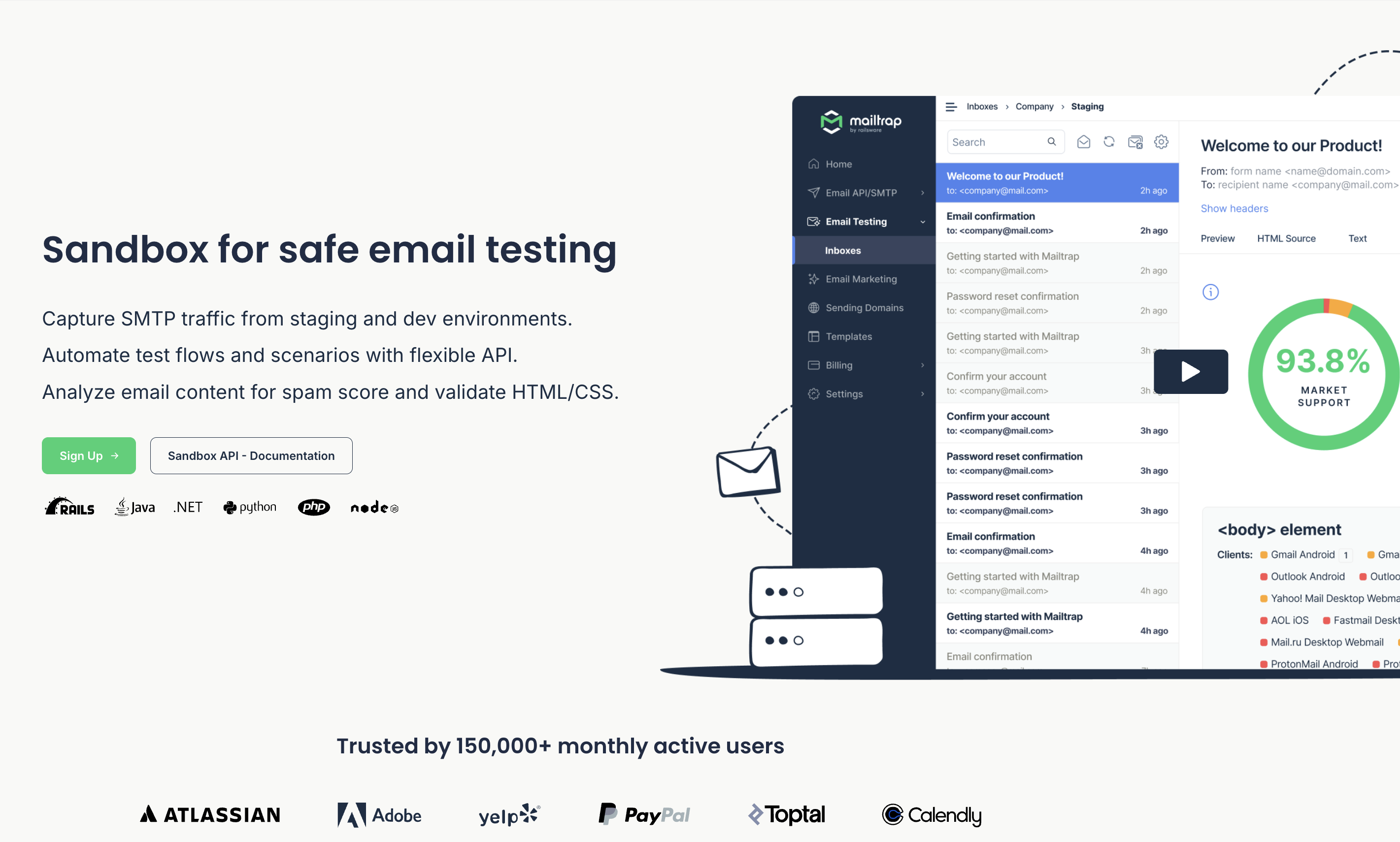
Email Sandbox provides you with a safe environment to inspect and debug emails in staging, dev, and QA environments. It also lets you preview and analyze content for spam and validate HTML/CSS before sending emails to recipients in production.
The service is geared towards developers and marketers who want to focus on high deliverability while having in-depth analytics,
How to use Email Sandbox
To test your email deliverability with Email Sandbox, follow these steps:
- Create a free Mailtrap account.
- Go to Email Sandbox → Inboxes.
- Open My Inbox (created by default).
- Select SMTP/API/POP3 under Integration.
- Copy/paste the provided credentials or code samples into your email-sending script.
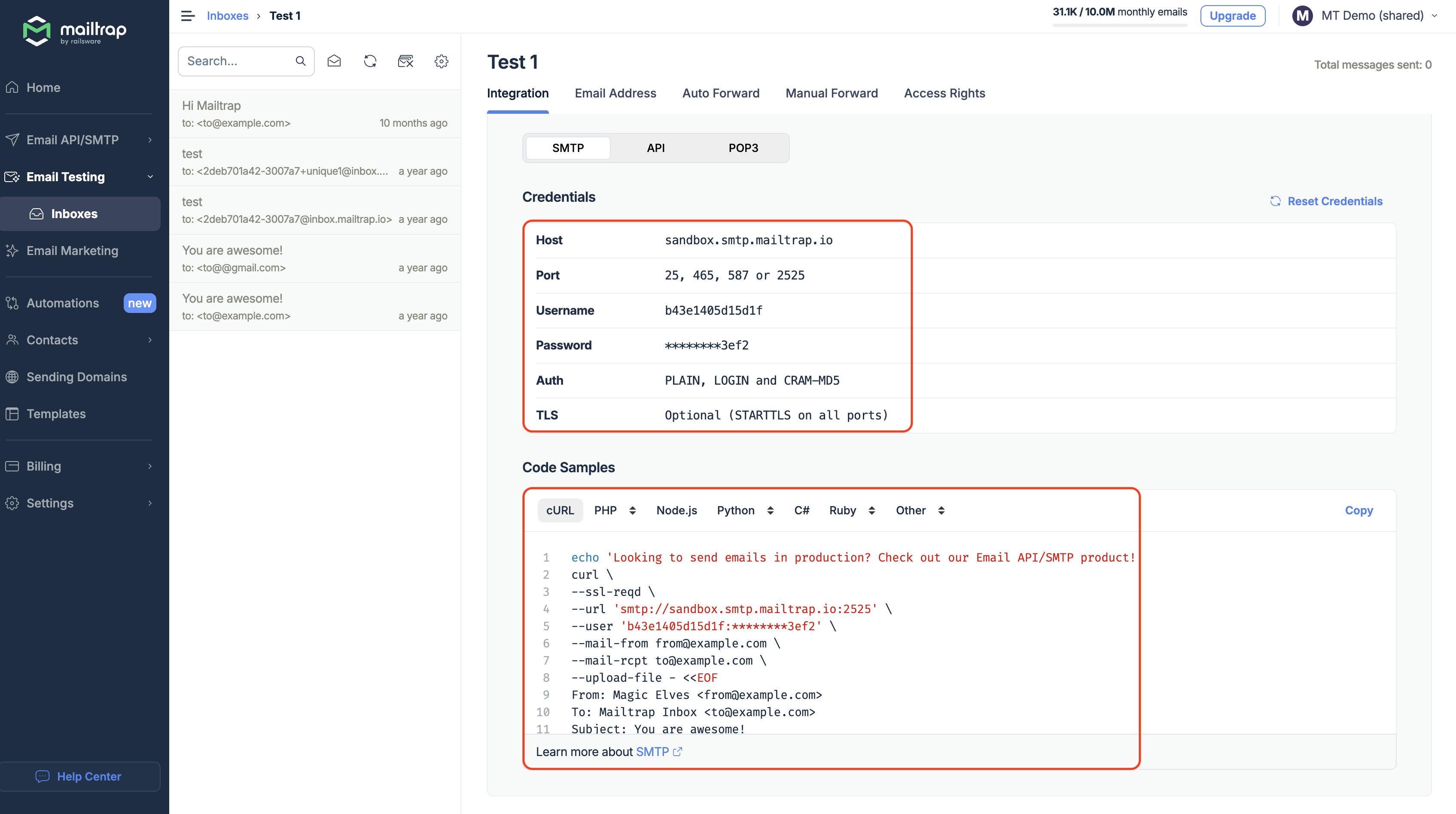
- Send the email from your application/project.
Once the email arrives in your inbox, you’ll be able to see how it looks in HTML or raw text, get detailed HTML and spam checks and other tech info.
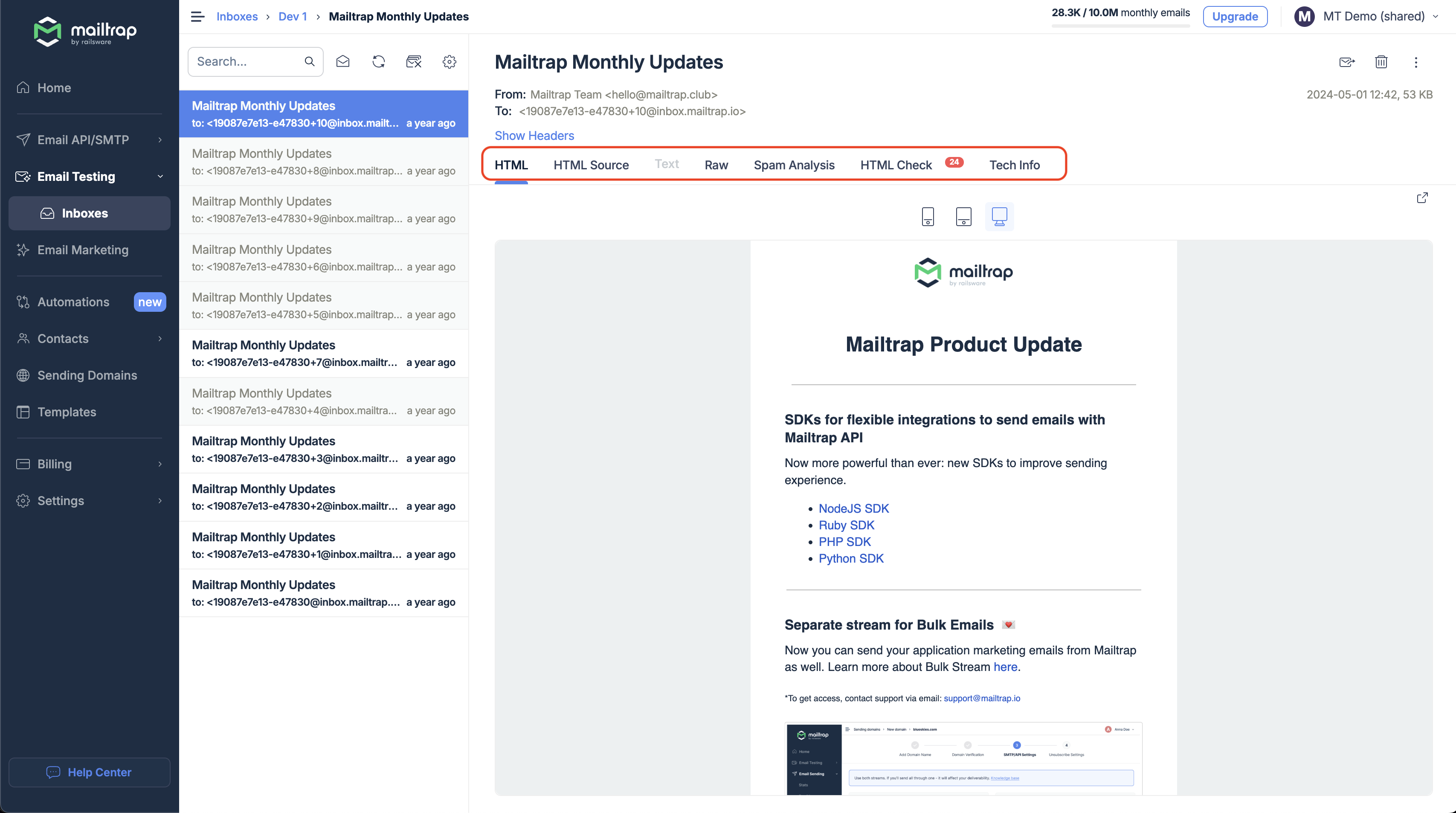
And for all of you visual learners out there, here’s a quick video tutorial on how Email Sandbox works. 👀
Additionally, you can also test your deliverability post-deployment if you choose to send emails with Mailtrap’s SMTP/API service or the Email Marketing suite. This way, you’ll get the most important deliverability metrics, such as delivery rates, open rates, clicks, spam, and more.

You can also set email categories to determine which type of email performs best with your audience. This is also useful for managing email marketing campaigns or performing A/B testing.
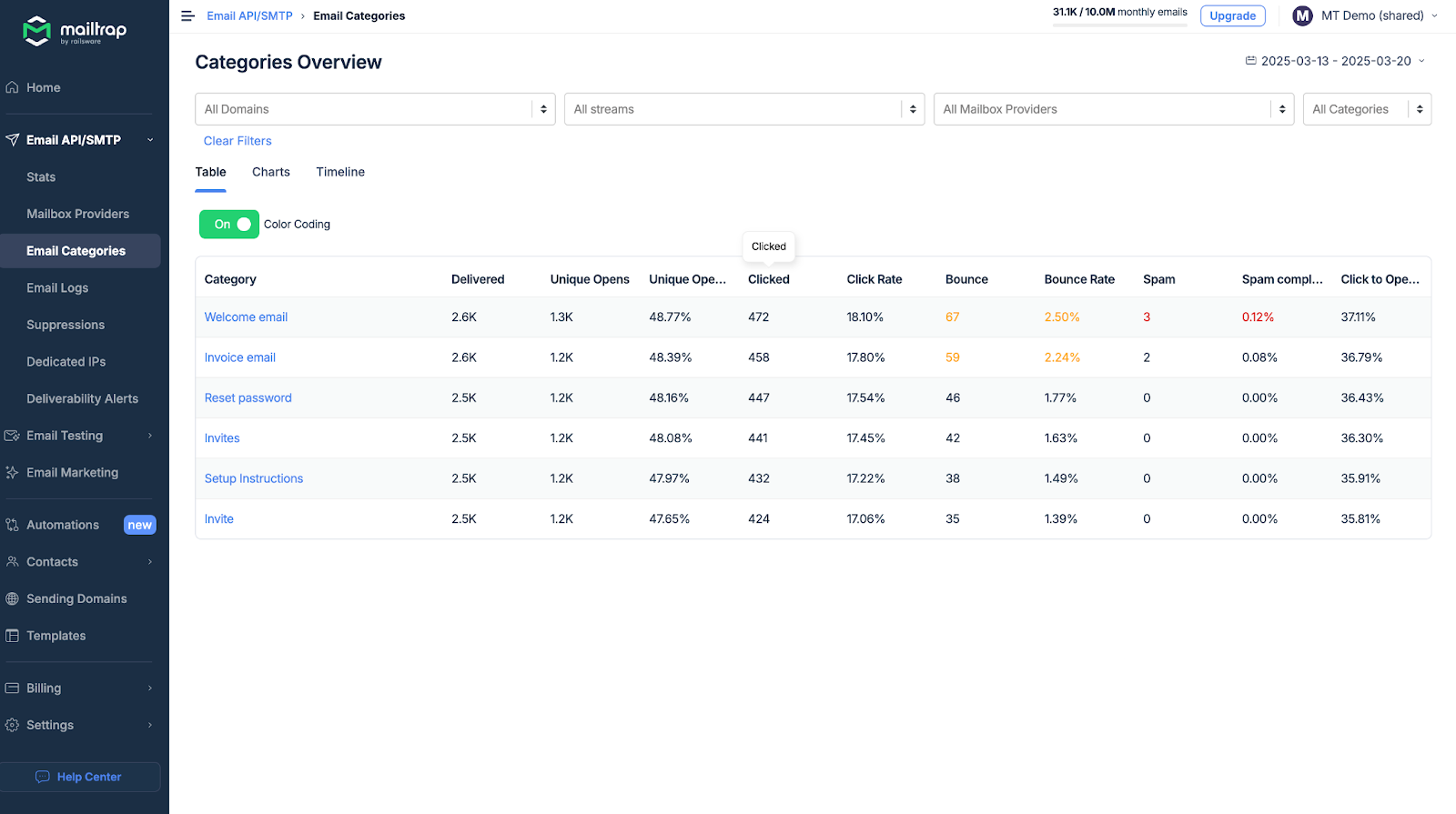
Email Sandbox features:
- HTML/CSS support – Check how your emails look with the most popular mailbox providers.

- Email preview – Preview your emails in HTML, raw, source, and more.
- Spam score check – Improve your email deliverability rates and prevent your emails from going to spam by keeping your spam score under 5.
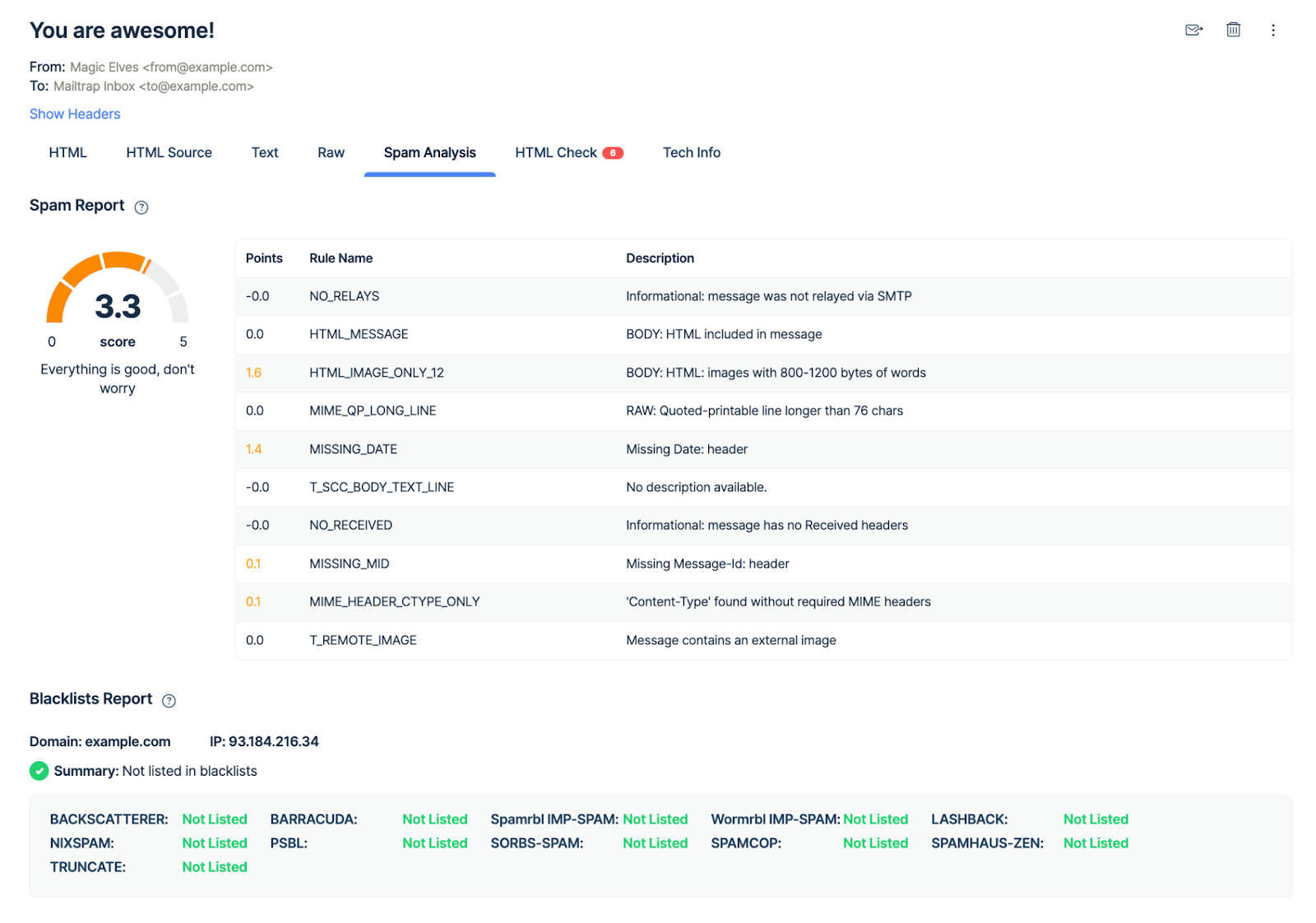
- API for QA automation – Cover all of your testing scenarios with our Email Sandbox API.
- Ready-to-use integrations in 20+ languages (Ruby, Python, Node.js, etc.) – Easily integrate your application with Email Sandbox
- Multiple inboxes for different projects and stages – Quickly find your data, switch between tasks, or share your testing results with colleagues or clients.
- Templates testing – Test your email templates with our API and then easily switch from staging to production environment once you’re ready to start sending.
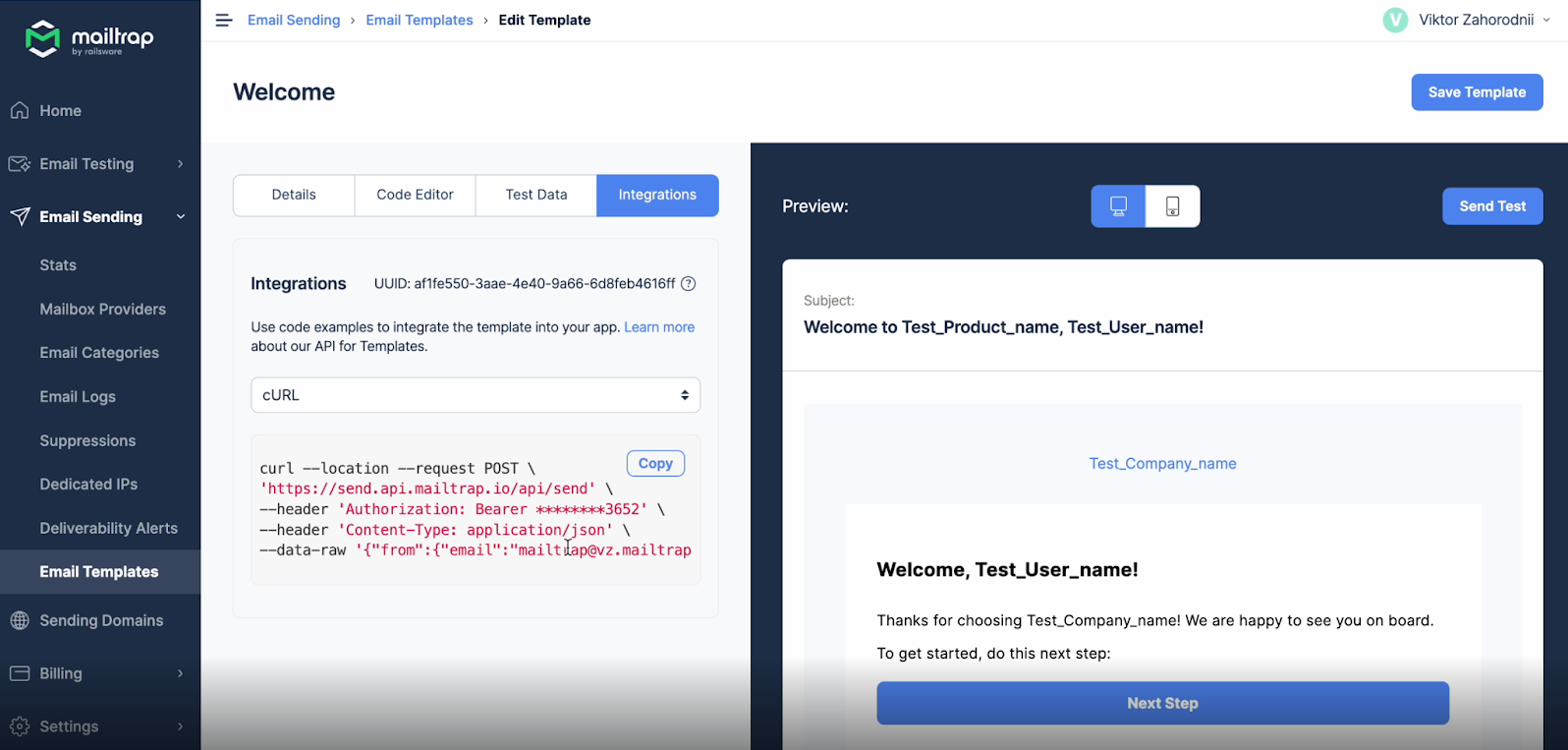
- Google Postmaster integration – Provide our deliverability team access to your Google Postmaster dashboard and get additional support and tips.
Pricing
Email Sandbox pricing plans are super simple: you have several tiers to choose from based on price, monthly test emails, and additional features that come with it, such as manual forwarding, maximum emails, etc.
Here they are summarized in a table:
| Plan | Monthly cost | Email tests/month |
| Free | $0 | 100 |
| Individual | $14.99 | 5,000 |
| Team | $34.99 | 15,000 |
| Business | $64.99 | 50,000 |
| Premium | $129.99 | 100,000 |
| Enterprise | $399.99 | 10,000,000 |
It’s worth noting that the Email Sandbox Team Plan is free for Open Source non-profit organizations or educational institutions. Additionally, SMTP/API services come together with the Email Marketing suite on the Sending plans.
For more details, please visit the official Mailtrap pricing page.
Customer experience
When it comes to online reviews, I’ve noticed a lot of people are enjoying Email Sandbox. A lot of users, like the one in the screenshot below, like the fact that they don’t have to worry about sending emails to real recipients:
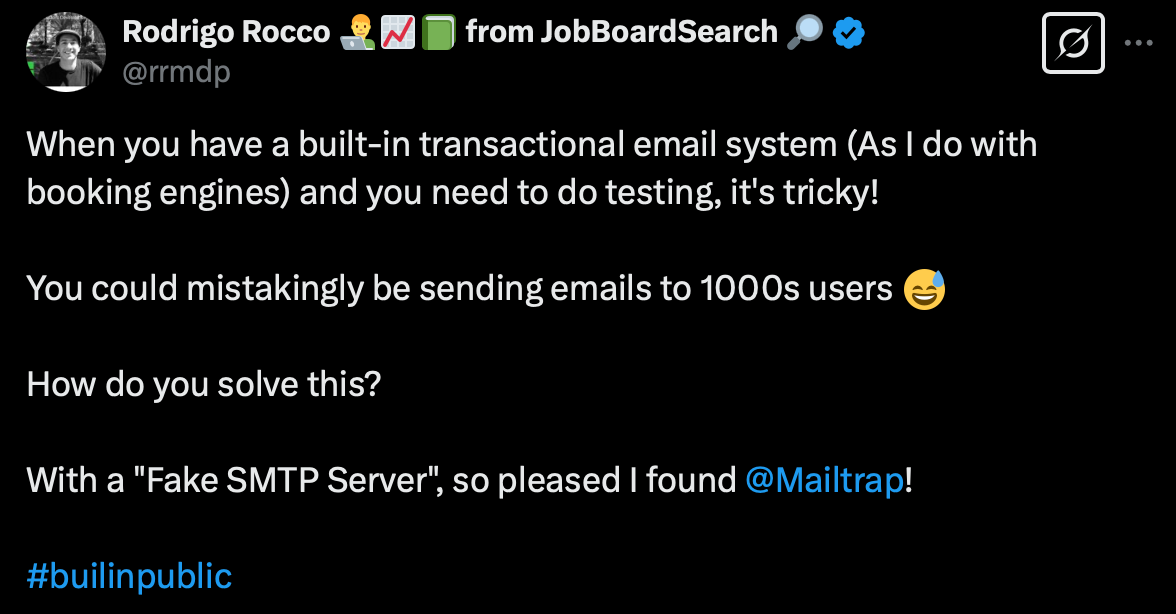
Bonus: Check your sender reputation with our free Domain Blocklist Checker and IP Blocklist Checker tools as well!
GlockApps – Email deliverability and inbox placement

GlockApps is an email deliverability testing tool that offers several tools for diagnosing deliverability and security issues, monitoring email placement, and improving the odds of your emails reaching your recipients’ inboxes.
The service is best for those who need an in-depth deliverability solution and can spend an extra few bucks on it.
The main GlockApps feature I’ll cover in this article is Inbox Insight, which allows you to see how your emails perform across different ISPs like Gmail, Office, or Outlook. It does this by emulating email-sending through Postfix and two other platforms for sending emails. It then estimates where your email would land.
How to use GlockApps (Inbox Insight)
- Log in to your GlockApps account.
- You have 3 tests with the free account.
- Select Inbox Insight → Dashboard on the left-side menu.
- Click on Start Spam Test.
- Select the Manual Test Start.
- You can also automate GlockApps to test each campaign before you send them.
- Choose the spam filters and email providers you want to test against.
- Select the folder to store your report to and add any notes (optional).
- Click on Create.
- Copy the message ID into your email and paste the provided email addresses (also known as Seed List) to the ‘To’ field.
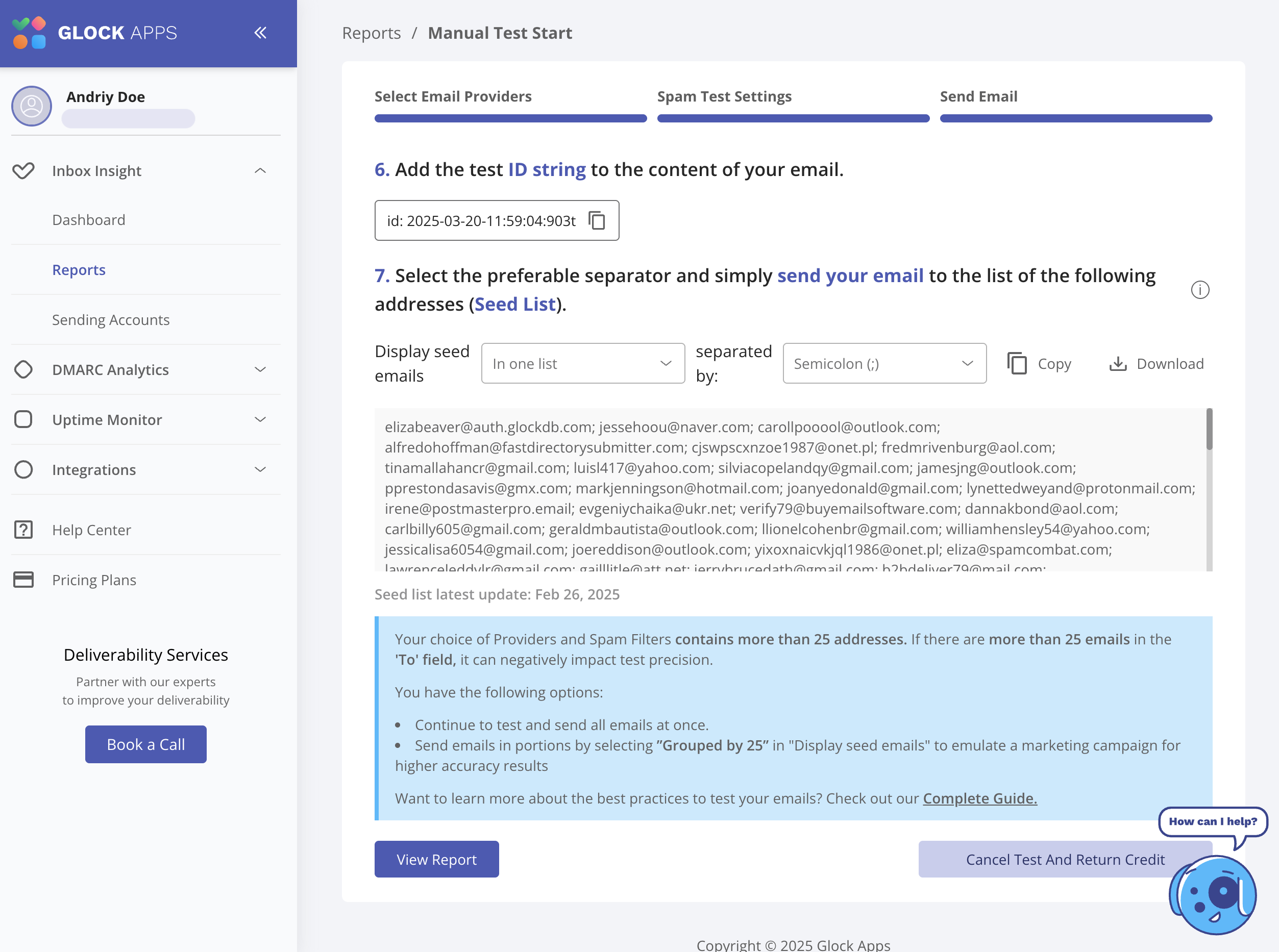
Lastly, after sending your email, go to the Reports section, where you can see your email placement results, IP analytics, domain analytics, and more.
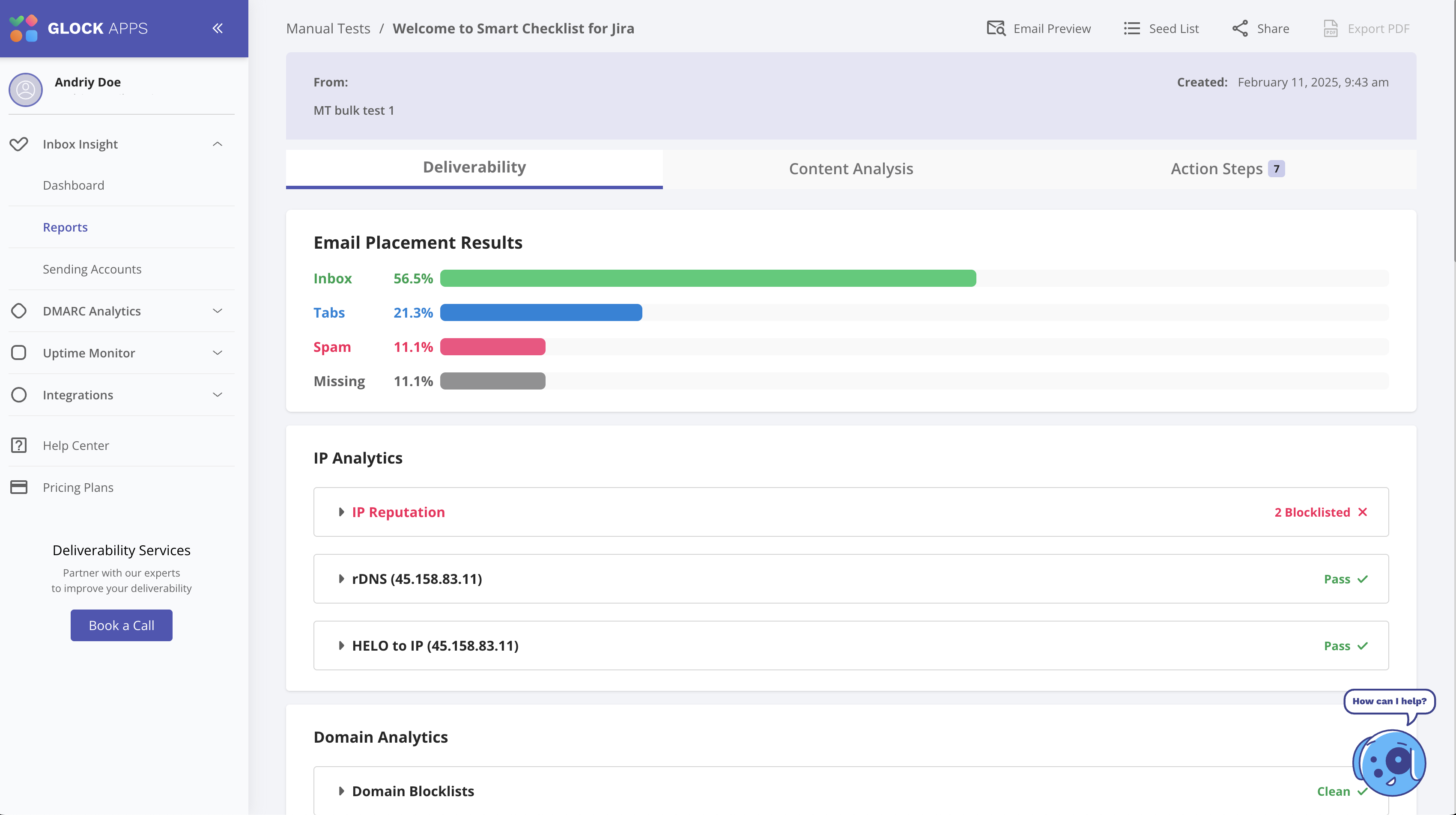
Moreover, you can also use GlockApps’ DMARC Analyzer, which provides you with in-depth and user-friendly DMARC analytics, weekly reports, dedicated support, and other little tools you can use to keep your email communication secure and maintain your sender reputation.
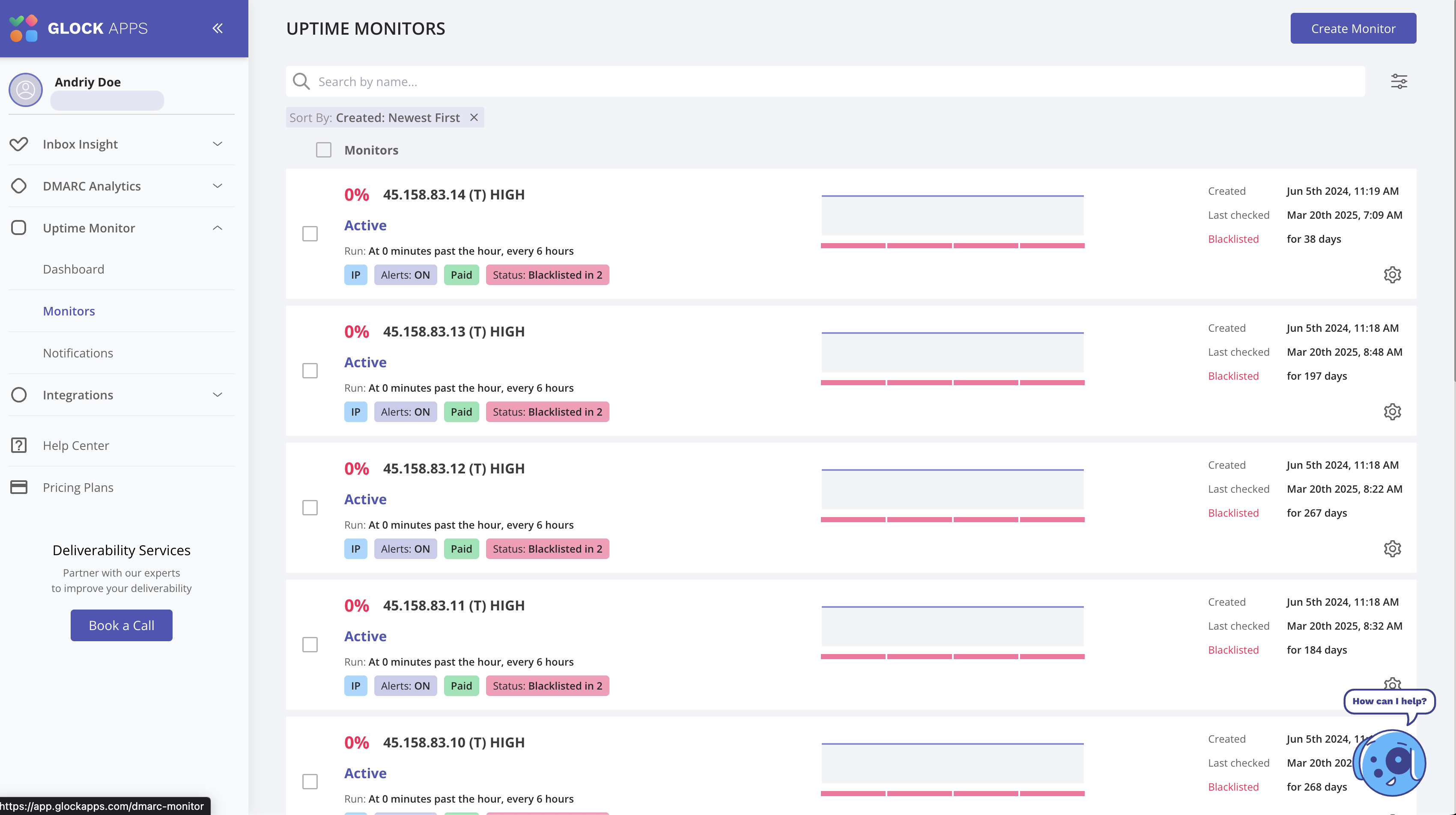
Or, you can monitor the health of your SPF, DKIM, and DMARC records, keep track of any potential downtimes of your website, and get notified if your IP gets blacklisted.
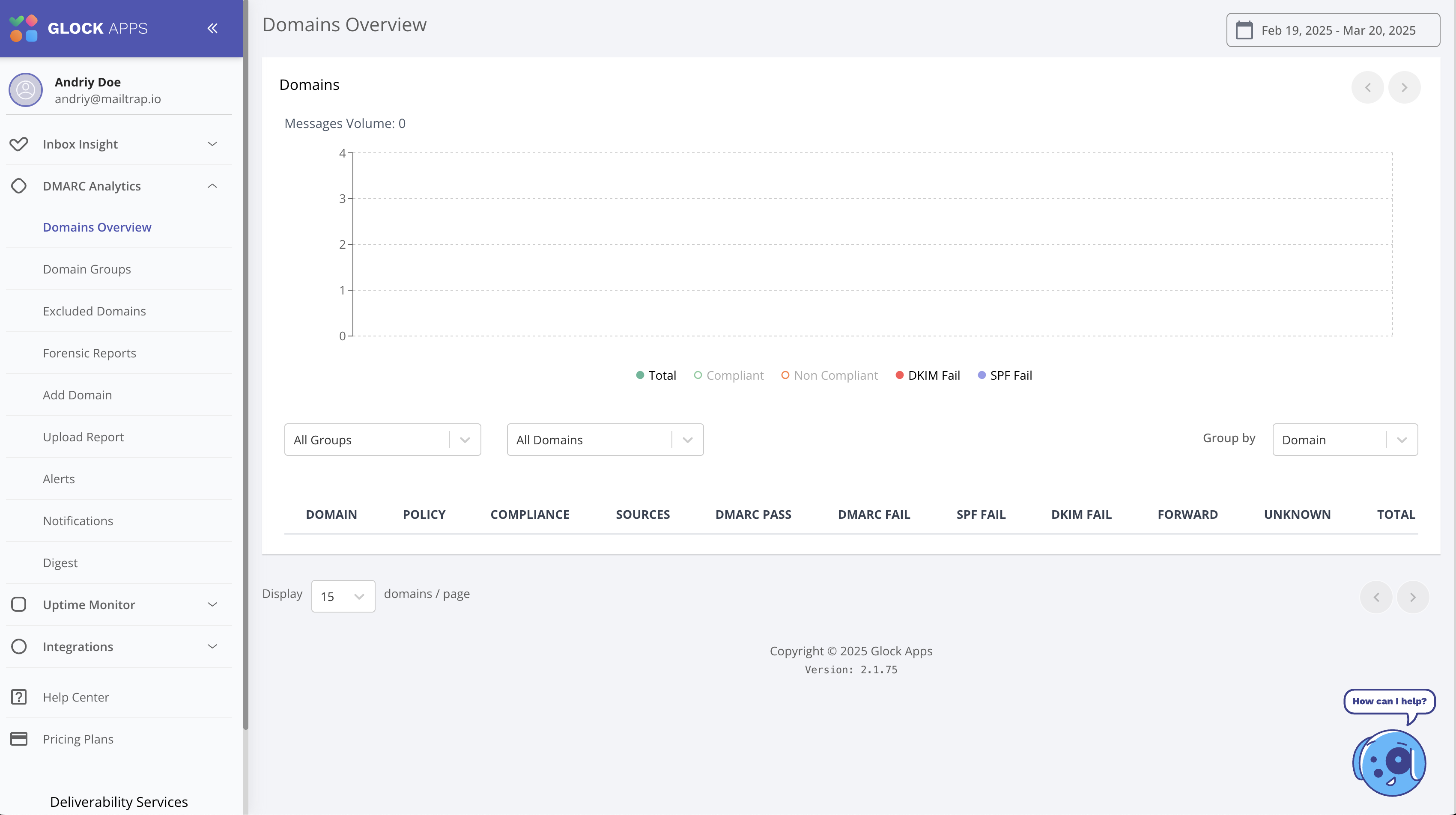
Features
- Domain analytics – Check for issues like spoofing or phishing attempts and monitor your domain’s reputation.
- Spam score – Evaluate your emails against major spam filters and get a spam score to optimize your email content.
- Cold email outreach tests – Test cold email campaigns and see how well they deliver and how much your recipients engage with them.
- Proxy tests – Evaluate how your emails perform across different networks and configurations.
- Personalized email deliverability consulting – Book a 1-hour consultation with one of GlockApps’ deliverability consultants.
- Google Postmaster integration – Similarly to Mailtrap, GlockApps allows you to integrate the Google Postmaster dashboard for extra stats.
It’s also worth noting that GlockApps offers a plethora of basic free tools, such as spam, DMARC, MX, TXT, and other checkers.
Pricing
As of writing this article, GlockApps offers separate plans for Spam tests and DMARC analytics. However, they also have a Bundle plan, which brings the best of both worlds together:
| Plan | Monthly cost | Spam test credits | DMARC analytics |
| Free | $0 | 2 | 10,000 |
| Essential | $85 | 30 | 50,000 |
| Growth | $142 | 90 | 100,000 |
| Enterprise | $185 | 150 | 1,000,000 |
For more details, please visit the official GlockApps pricing page.
Customer experience
Whether I went on Reddit or X, or even Trustpilot, I’ve seen nothing but positive comments on GlockApps, similar to this one:

MailerCheck – Email list verification, deliverability, and inbox placement
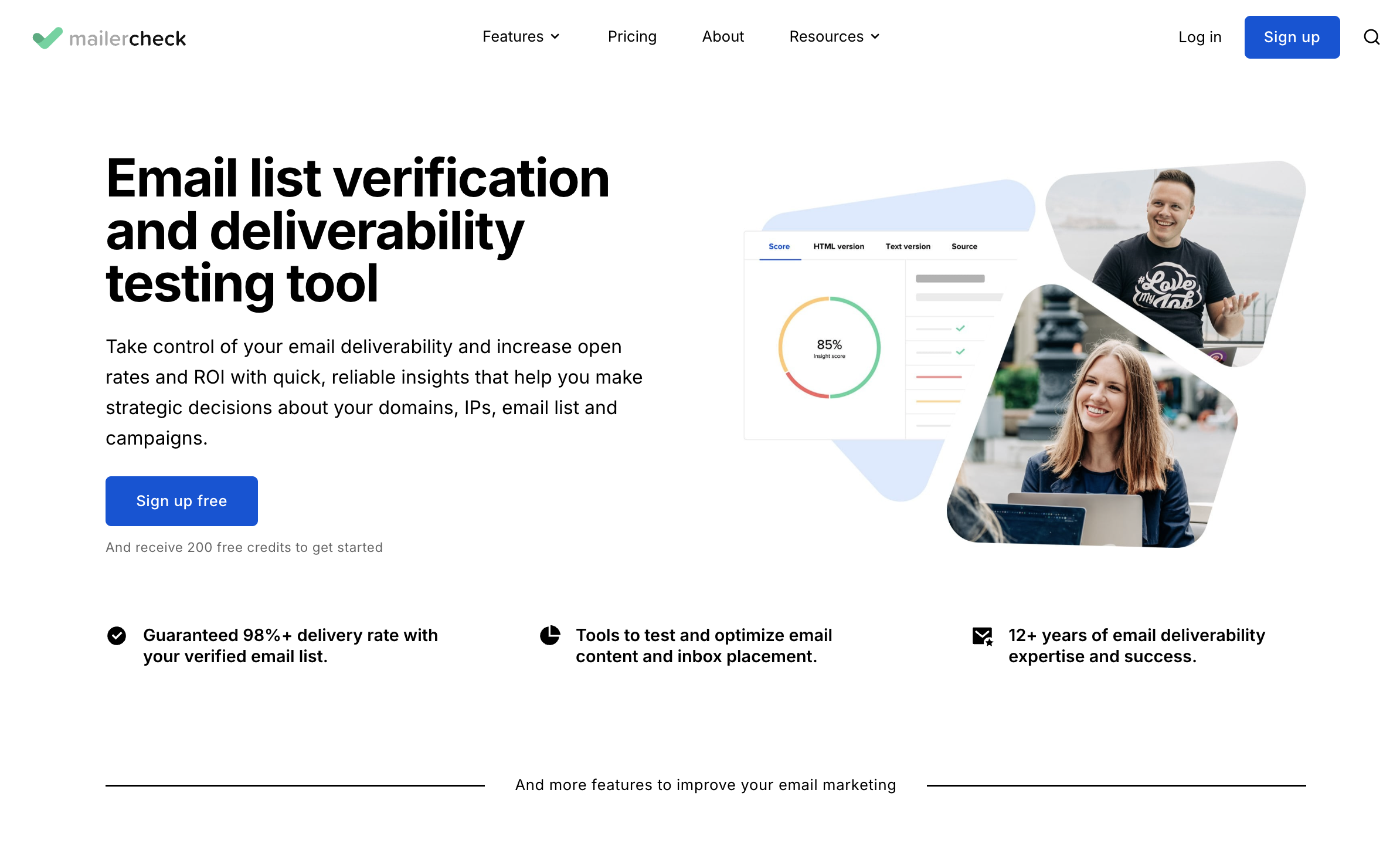
To quote its creators: “MailerCheck is a “more affordable GlockApps alternative that offers flexible plans for businesses as well as a reliable email verification tool.” After giving it a try for some time while preparing this article, I’d say that is true, but only to some extent.
Namely, MailerCheck is for people who need a more minimal and affordable GlockApps. So, inbox insights, usage reports, and monitoring, just without the advanced features like Postmaster integration, email logs, uptime monitoring, or deliverability consulting.
How to use MailerCheck
- Log in to your MailerCheck account.
- Go to Inbox Insights on the left-side menu.
- Enter your report name and description (optional).
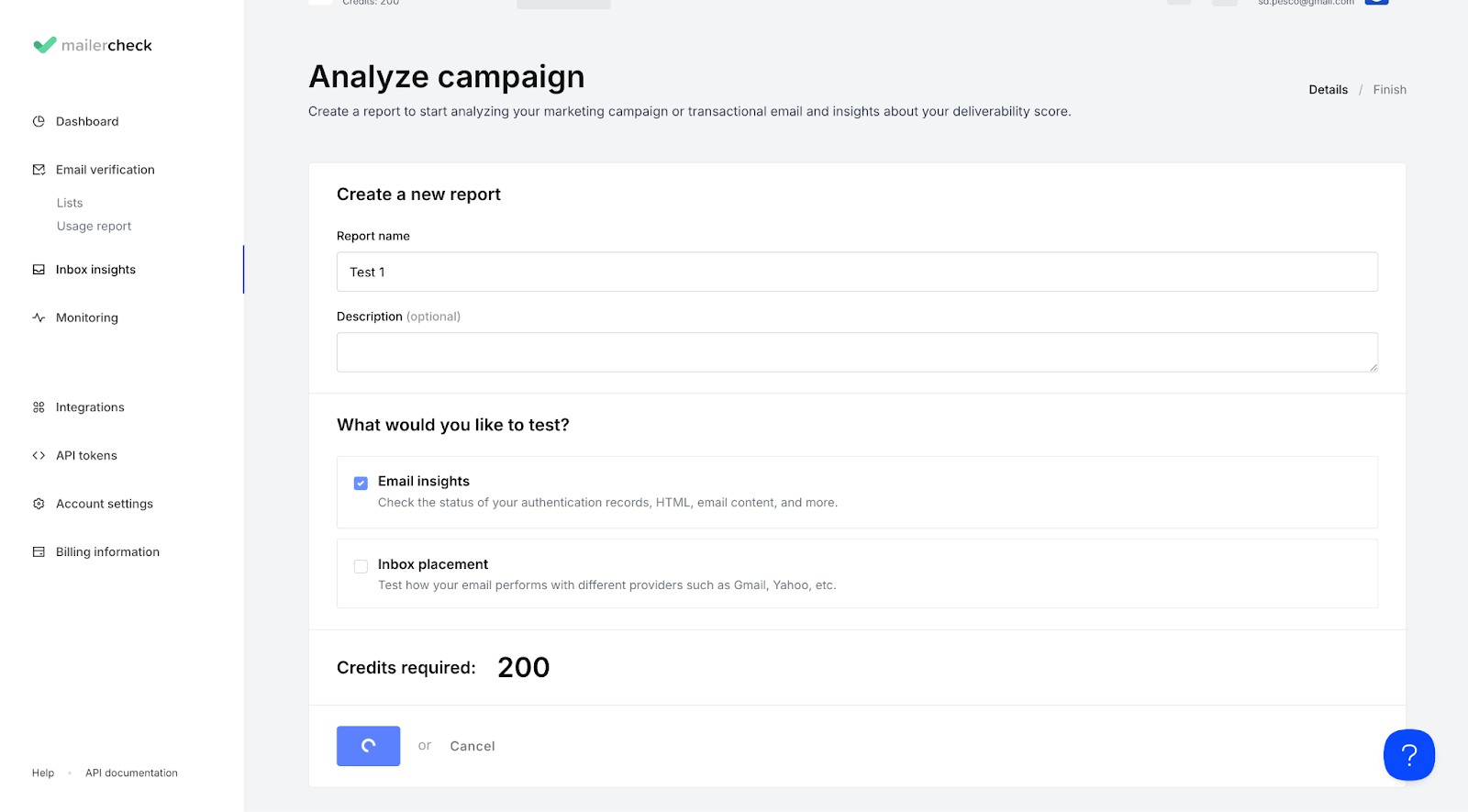
- Check Email Insights and click OK.
- You can also use the Inbox placement feature to check how your emails perform with different providers, but for this, you’ll need twice the credits.
- Copy/paste the provided email address and send your email campaign to it.
The results should come in a minute or two both on the dashboard and your inbox, where you’ll be able to see whether your emails passed spam filters, whether your HTML is on point, and more.
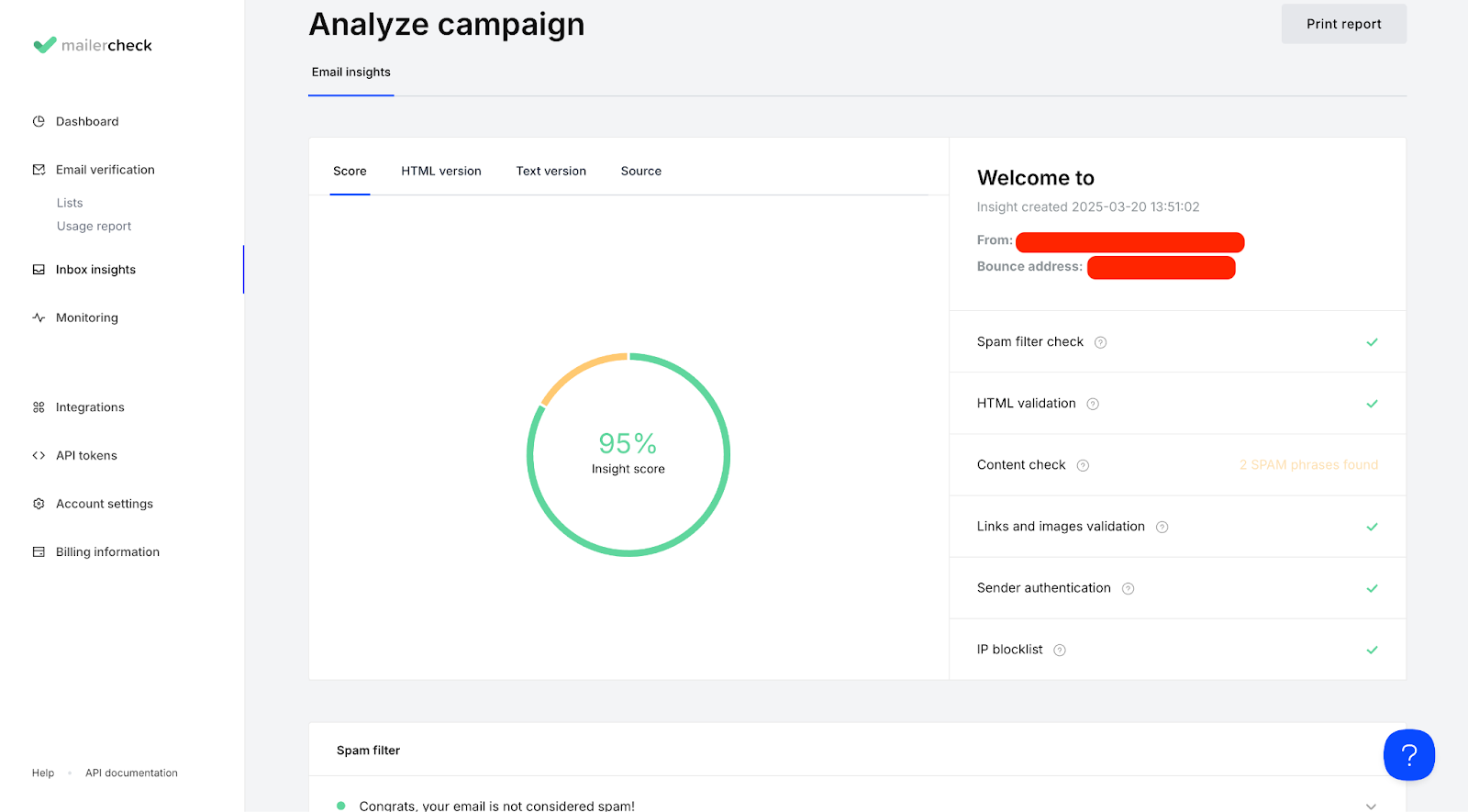
Features
- Bulk email validation – Keep your email list clean by removing invalid, harmful, disposable, and other addresses by running them through MailerCheck’s validator.
- Real-time API verification – You can also use MailerCheck’s validation API to validate new addresses as you collect them, instantly filtering out the faulty ones.
- Usage reports – Get insights on your email lists and improve your deliverability by sending emails to users with valid addresses who are more likely to engage.
- DMARC monitoring and reporting – Keep track of your domain use and troubleshoot your deliverability in real-time.
- Blocklist monitoring – Get alerts when your IP address or domain appears on a blacklist.
Pricing
First things first, MailerCheck offers a free plan, which you can use for a single deliverability check. However, you can also use it to validate 200 emails.
On the other hand, the pricing is quite fair I’d say, although the curve is a bit steep for the higher-end plans, which is why I don’t think it’s more affordable than GlockApps.
Nonetheless, check it out for yourself:
| Plan | Price/per month | Users | DMARC domains | Blocklist monitors |
| Free | $0 | 1 | 1 | 2 |
| Basic | $125 | 1 | 10 | 66 |
| Premium | $245 | 5 | 20 | 256 |
| Enterprise | $975 | Unlimited | Unlimited | 1024 |
But, there is also the option to pay as you go, which lets you purchase between 1,000 to 5,000,000 credits. This can be useful if you’re a single-time user or want to check out the platform.
For more information, please consult the official MailerCheck pricing page.
Sender Score – Sender reputation and domain health
G2: N/A Capterra: N/A

Sender Score is a free email deliverability testing tool by Validity, which you can use to monitor your sender reputation, see if your domain is on blocklists, and more.
Since it’s a free solution and doesn’t offer any advanced features, I’d say this tool is best for those who are just getting into email marketing and deliverability in general. Or those who need a quick test for their project before they switch to a paid solution.
How to use Sender Score
- Open Sender Score in your preferred browser
- Enter your domain or IP address
- Fill out the additional information and click What’s my score?
In a few moments, you’ll be able to see your sending domain information, SSL information, sending IPs, and more.
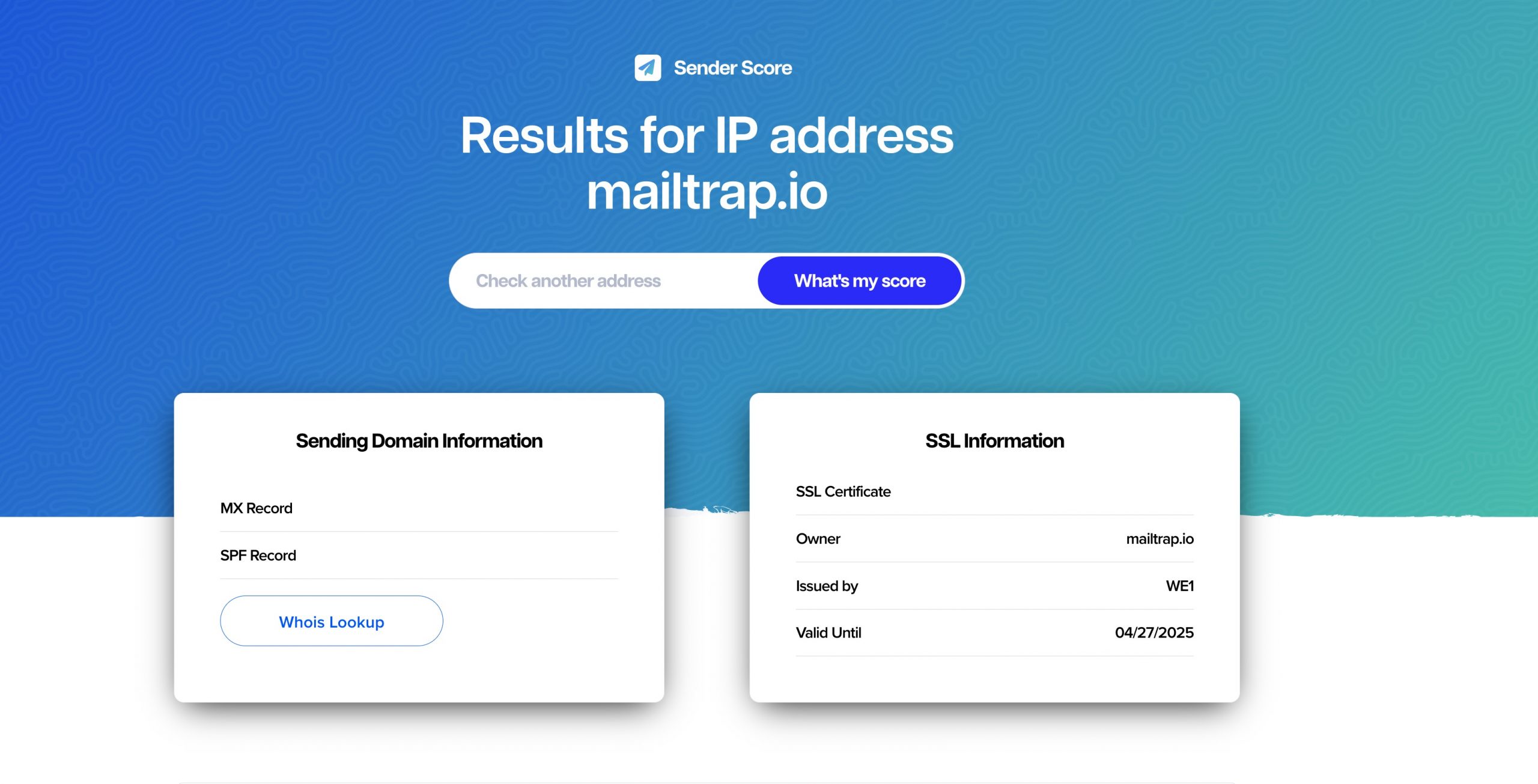
Then, you can go to Access → Deliverability Benchmarks and see how you fare to others in your industry. Simply enter your email, choose your sending amount, and click on See the global averages.
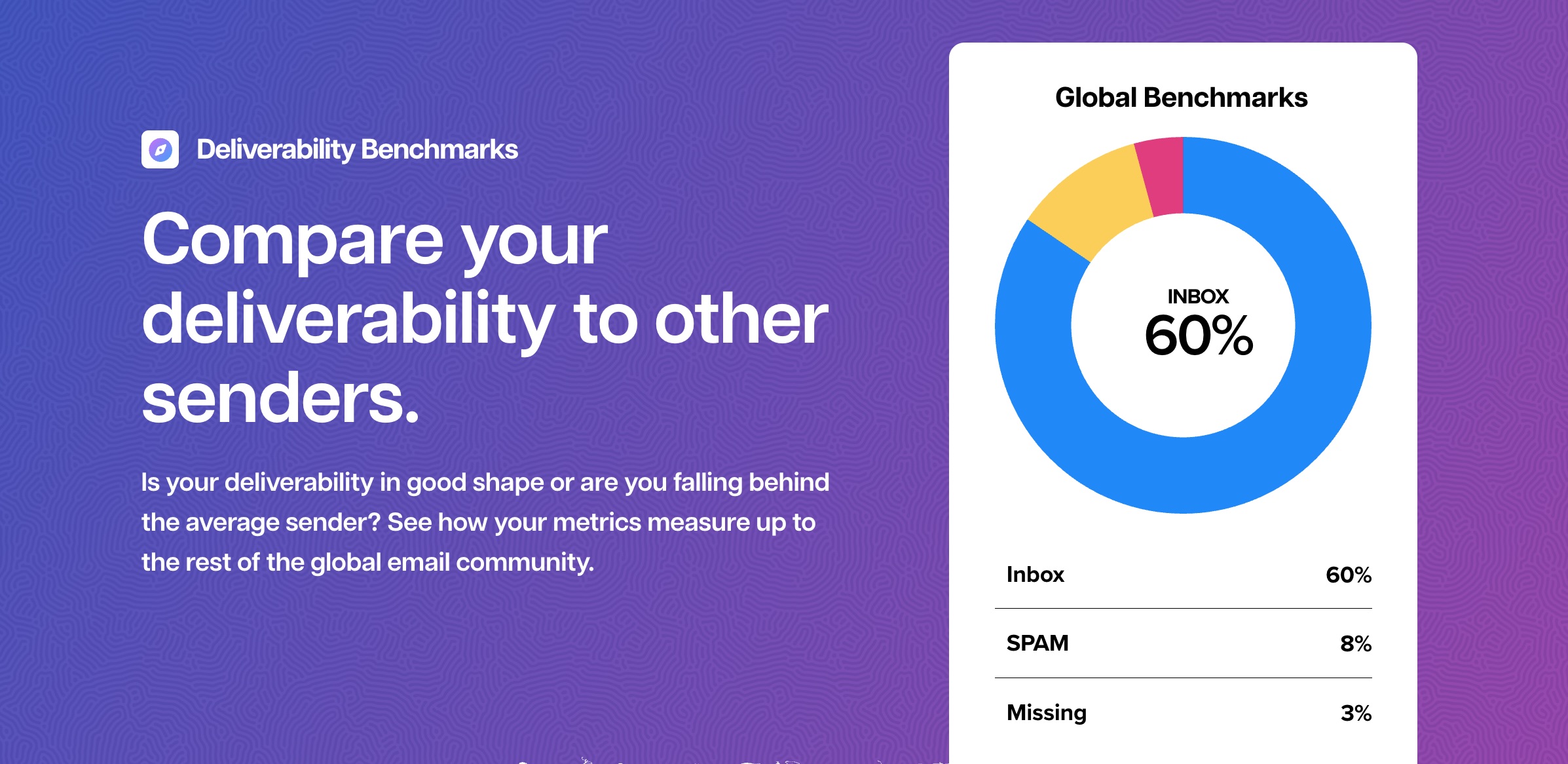
Features
- Blocklist lookups – See if your domain is being blocklisted.
- List quality checks – Upload your contact list and have it validated by BriteVerify, another part of Validity.
- Email revenue calculator – Use Sender Score’s revenue calculator to get a prediction on the potential of your campaigns’ earnings.
- Deliverability consultation – Get a free 1-hour consultation with one of Sender Score’s email deliverability experts.
- Bounce lookups – Check why your emails are bouncing and significantly improve your deliverability.
- Subscriber list analyzer – See which mailbox providers make up the majority of your email list.
- Subject line preview – Test your subject lines and pre-headers across 20 email clients and see how they perform.
- Blocklist remover – In case your IP is blocklisted, you can enter your IP address and check if it’s on the return path blocklist.
I’d also like to point out that Sender Score has a great knowledge base, where you can learn a lot on deliverability and all things email through podcasts, video lessons, and newsletters.
Customer experience
To be honest, I haven’t found many reviews of Sender Score online. However, I’ve noticed that many people mention it in lists on improving email deliverability and found no complaints. Unfortunately, no reviews. 🙁
MxToolbox – Sender reputation and domain health
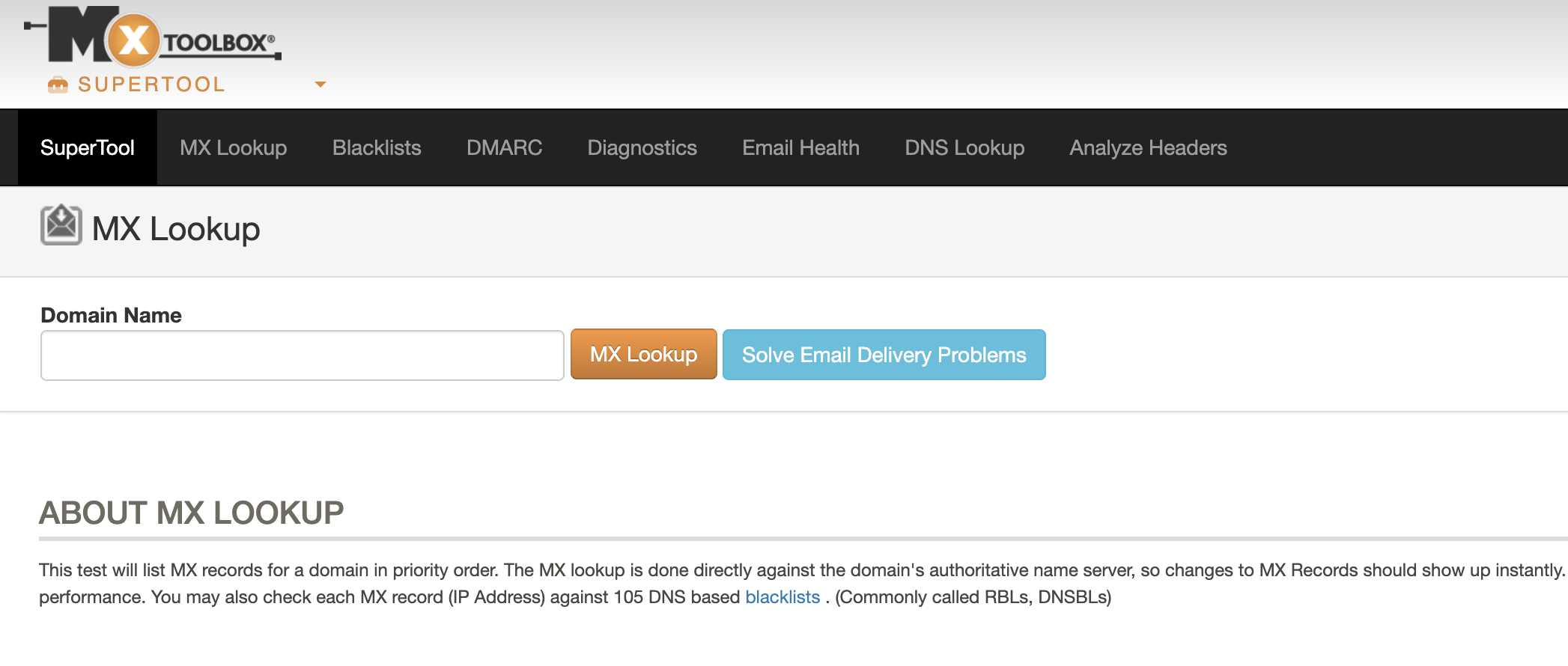
MxToolbox is a service launched way back in 2004, offering various tools aimed at helping improve the domains’ capabilities.
Since it’s free (if you don’t want the extra features), MxToolbox is best for people looking for a quick deliverability check.
How to use MxToolbox
The MxTool I’ve used the most is the deliverability tool, which allows you to validate your domains’ email authentication methods.
To use it, all you need to do is send a test email to ping@tools.mxtoolbox.com. Shortly, you will get an email in your inbox (check the Updates tab) with the test results.
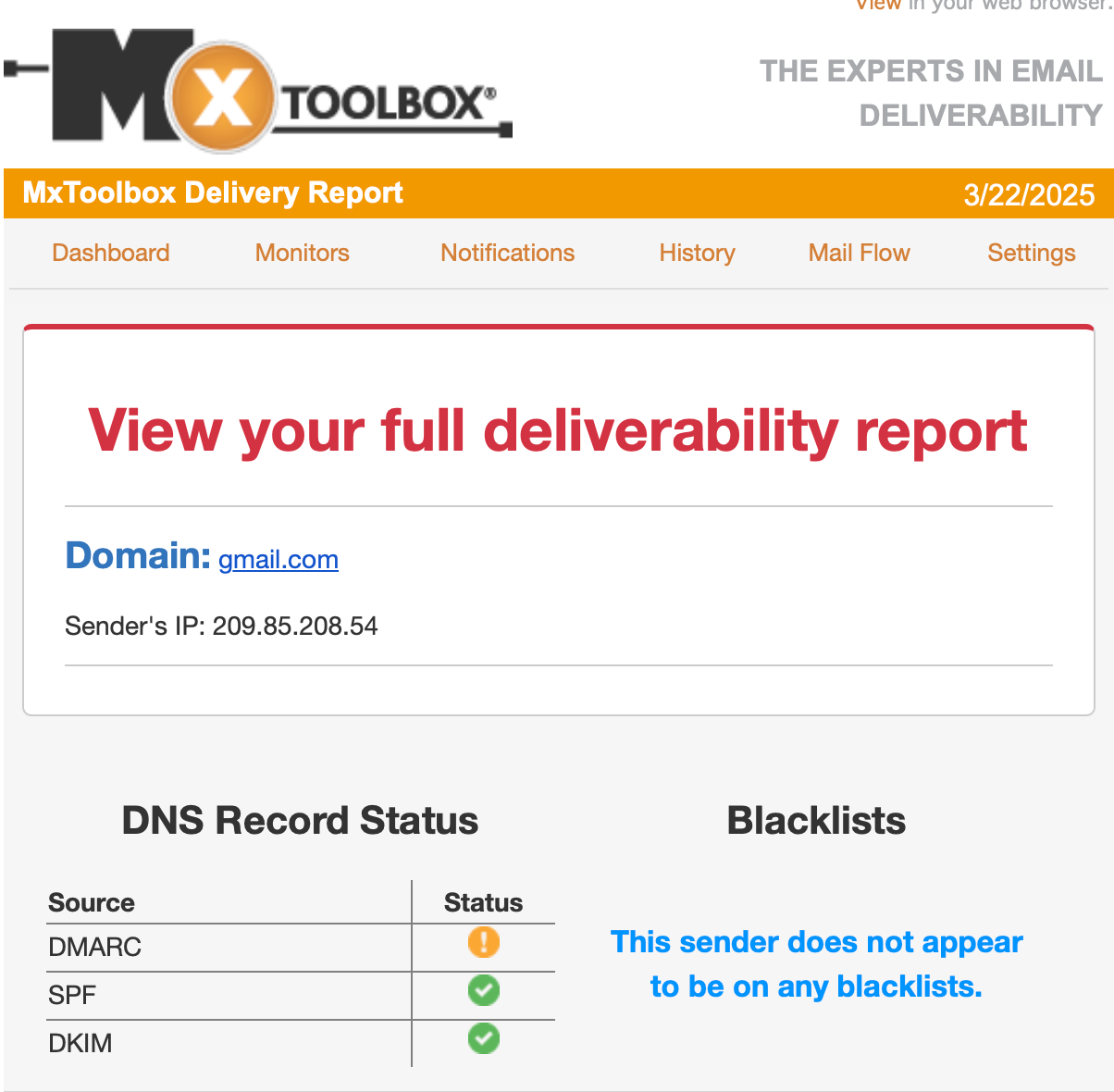
Click on ‘View your full deliverability report,’ and you’ll see the detailed report.
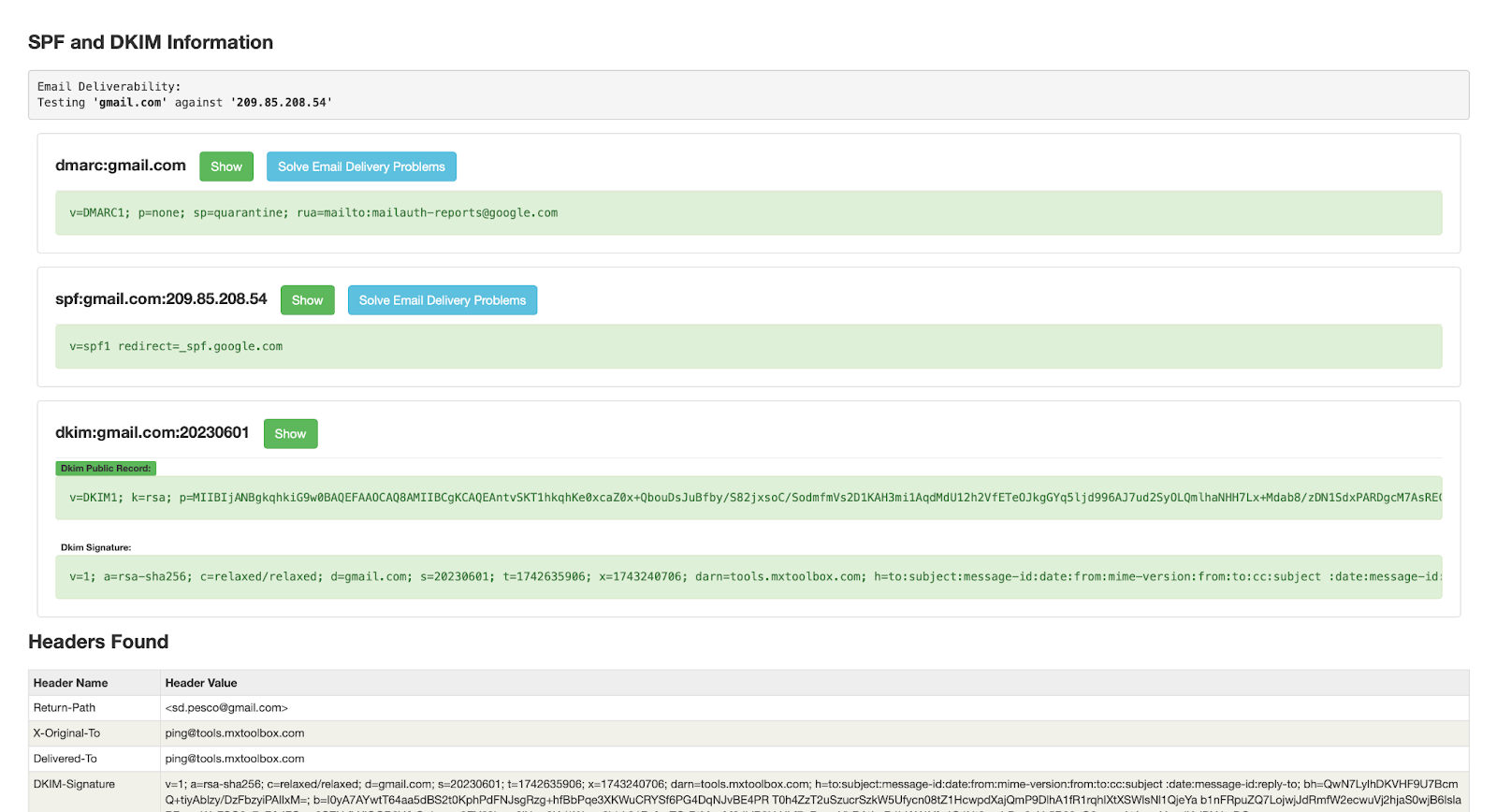
Features
Besides allowing you to test your domains’s authentication, MxToolbox also offers tools for:
- Performing blacklist checks
- Looking up DNS records
- Checking domain health
- Performing reverse lookups
- Testing email servers
- And more.
You can use all of these features by visiting the MxToolbox SuperTool.
Pricing
If the free tools MxToolbox is offering are not enough for you, you can switch to one of the paid plans, which are quite simple;
| Plan | Monthly cost | Key Features | Domain(s) | Email message volume |
| Free | $0 | Free lookups | 1 | N/A |
| Delivery Center | $129 | Inbox placement analysis Email delivery performance Email configuration analysis And more | 5 | 500,000 |
| Delivery Center Plus | $399 | Same as Delivery Center + Advanced email delivery threat tools SPF record flattening And more | 5 | 5,000,000 |
For more details, please visit the official MxToolbox pricing page.
Customer experience
Having been launched in 2004, it’s no surprise that the veteran of the email game MxToolbox has a plethora of positive reviews online. Whether it’s Trustpilot or Reddit, you can find only praises about it.
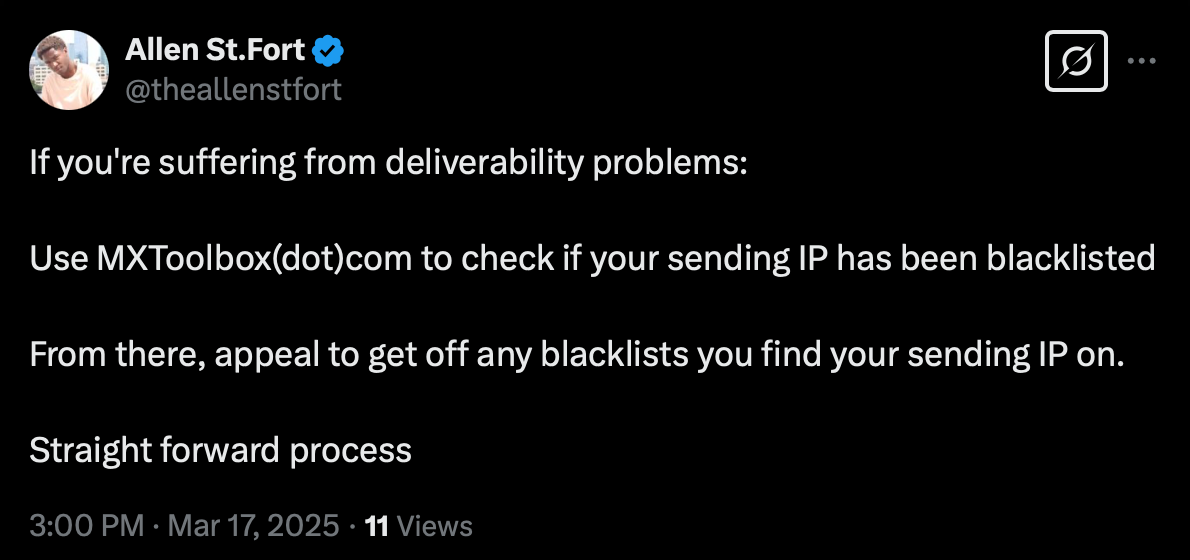
Ready, set, test
And with that, we’ve reached the end of our article!
Now, all you have to do is choose your tool(s) and test your email deliverability! The choice is completely up to your preferences, but we sincerely hope Mailtrap makes the cut!
One for the road: You can also test email deliverability manually. Learn how to do that by watching the step-by-step video we’ve prepared for you:





Comments
2 replies